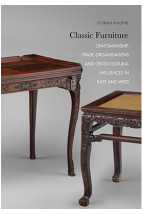Classical Chinese Huanghuali Furniture from the Haven Collection
(晏如居藏明式黃花梨家具)
ISBN : 978-988-19023-8-2
Distributed for HKU Museum and Art Gallery 香港大學美術博物館
October 2016
358 pages, 9″ x 12″, color illus.
- HK$800.00
Also Available on
The University Museum and Art Gallery at The University of Hong Kong presents Classical Chinese Huanghuali Furniture from the Haven Collection and publishes this informative edition in conjunction with the exhibition. Chinese huanghuali furniture is world-famous and, for the longest time, has been collected in both East and West. The fine selection displayed here shows both domestic furniture and scholars’ items, such as brush pots and chests.
In Ming dynasty China, traditional wood architecture and Buddhist thrones inspired Chinese furniture makers and, as trade expanded, so did the amount of hardwood furniture in the form of sophisticated movable pieces and built-in interiors. Ming furniture is known for its elegant lines and carved details. During the reign of Emperor Longqing (1567–1572) China opened its borders, previously implemented import bans were lifted and a greater variety of building materials became available. Consequently, during the Ming and Qing dynasties (1368–1911) the most celebrated types of domestic furniture were made from huanghuali and zitan woods. The elegant dark hardwood with natural shine is remarkable for the fact that Chinese furniture is typically made from solid timber, not an invisible sub-construction covered by a decorative veneer, as is so often the case in the West. The strength of each individual element of a piece of furniture and the consistent colour matters, as every detail is exposed and the precision of the joints, the size and position of the dowels, are all visual elements of an often very simple and graceful design. In some pieces the joints are detectible and accessible, sometimes demountable, or else expertly hidden in the more sophisticated pieces. Applied surface finishes were generally only a layer of wax; no stains or clear lacquer seals were added to the dense and inherently decorative woods.




